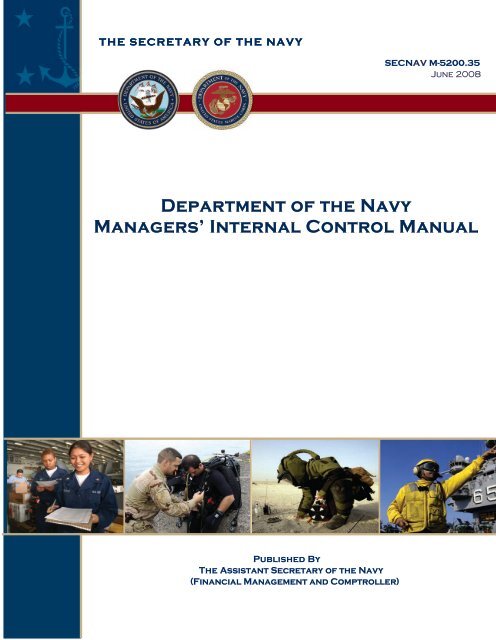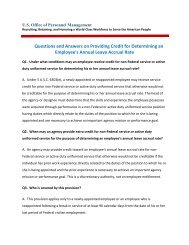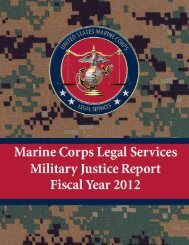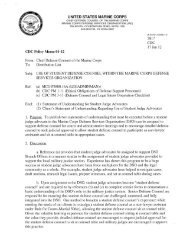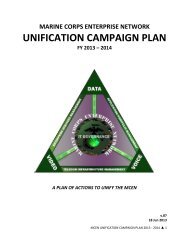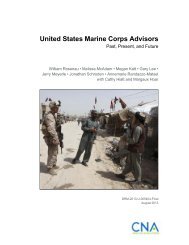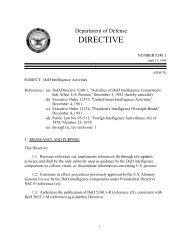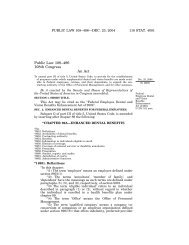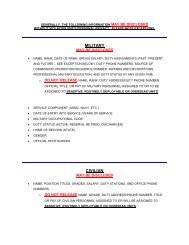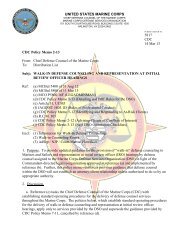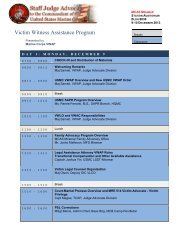SECNAVINST 5200 - Navy Issuances
SECNAVINST 5200 - Navy Issuances
SECNAVINST 5200 - Navy Issuances
Create successful ePaper yourself
Turn your PDF publications into a flip-book with our unique Google optimized e-Paper software.
THE SECRETARY OF THE NAVYTHE SECRETARY OF THE NAVYSECNAV M-<strong>5200</strong>.35June 2008Department of the <strong>Navy</strong>Managers’ Internal Control ManualPublished ByThe Assistant Secretary of the <strong>Navy</strong>(Financial Management and Comptroller)
SECNAV M-<strong>5200</strong>.35JUNE 2008COVER PAGEThis page is intentionally blank.1
THE ASSISTANT SECRETARY OF THE NAVY(FINANCIAL MANAGEMENT AND COMPTROLLER)1000 NAVY PENTAGONWfI.SHINGTON DC 20350-1000June 2, 2008FOREWORDThis manual implements the policy set forth in Secretary of the <strong>Navy</strong> Instruction(<strong>SECNAVINST</strong>) <strong>5200</strong>.35E, Department {~fthe <strong>Navy</strong> (DON) Managers' Internal Control(MIC) Program, regarding internal controls throughout the DON and is issued under theauthority of <strong>SECNAVINST</strong> 5430.7N, Assignment ofResponsibilities and Authorities inthe Office ofthe Secretary ~lthe <strong>Navy</strong>, dated 9 June 2005.This manual specifies procedures for implementing an effective internal control programthroughout the DON, and will serve as management's basis for the Department's annualStatement of Assurance to the Secretary of Defense.This manual is effective immediately; it is applicable to the Offices of the Secretary ofthe <strong>Navy</strong>, the Chief of Naval Operations, the Commandant of the Marine Corps, and all<strong>Navy</strong> and Marine Corps activities, installations, commands, ships and stations.This manual may be accessed through the DON <strong>Issuances</strong> website: http://doni.daps.dla.mil/default.aspx. For further assistance or to offer comments or recommendationsconcerning this manual, the DON MIC Program Coordinator may be contacted atMICtraining@navy.mil or via the office delineated below:Office of Financial Operations720 Kennon St. SEBldg 36, Room 115Washington <strong>Navy</strong> Yard, DC 20374-5025Commercial: (202) 685-6708DSN: 325-6708ou S rookAssistant Secretary of the <strong>Navy</strong>(Financial Management & Comptroller)
SECNAV M-<strong>5200</strong>.35JUNE 2008Department of the <strong>Navy</strong> (DON) Managers’ Internal Control (MIC) ManualTable of ContentsFOREWORD................................................................................................................... 2Table of Contents............................................................................................................ 3Introduction to the DON Managers’ Internal Control (MIC) Program............................... 5MIC Program Overview ................................................................................................... 7DON Major Assessable Units ...................................................................................... 7Senior Management Council ....................................................................................... 7Senior Assessment Team............................................................................................ 8Assessable Units ......................................................................................................... 8MIC Program Documentation Requirements................................................................. 10Risk Assessment Documentation .............................................................................. 10Control Assessment Documentation.......................................................................... 14Corrective Action Plans ............................................................................................. 16The Managers’ Internal Control (MIC) Plan ............................................................... 16Statement of Assurance ................................................................................................ 21Reporting Period........................................................................................................ 21Determining Materiality .............................................................................................. 21Department of Defense Internal Control Reporting Categories ................................. 23Statement of Assurance Tool ........................................................................................ 25Preparing a MIC Certification Statement ....................................................................... 25Tab A: Accomplishments ........................................................................................... 28Tab B-1: Listing of Material Weaknesses, Reportable Conditions and Items-to-be-Revisited; Uncorrected and Corrected.................................................................... 29Tab B-2: Uncorrected Material Weaknesses, Reportable Conditions and Items-to-be-Revisited................................................................................................................. 30Tab B-3: Corrected Material Weaknesses, Reportable Conditions and Items-to-be-Revisited................................................................................................................. 34Submitting Instructions .................................................................................................. 36Managers’ Internal Control Training .............................................................................. 37DON MIC Program Training ...................................................................................... 37DON MIC Training for Managers ............................................................................... 37Accessing the Computer Based Training Courses .................................................... 38ReferencesFigure 1: Information Flow for Annual Statement of Assurance ...................................... 6Figure 2: Risk Diagram.................................................................................................. 11Figure 3: Risk Assessment Process Flow ..................................................................... 11Table 1: FY 2008 DON MIC Major Assessable Units...................................................... 7Table 2: DON MIC Senior Assessment Team................................................................. 8Table 3: Risk Type and Level Table.............................................................................. 133
SECNAV M-<strong>5200</strong>.35JUNE 2008Example 1: FMO Inventory of Assessable Units ............................................................. 9Example 2: Process Flowchart...................................................................................... 12Example 3: Risk Assessment Table.............................................................................. 14Example 4: Control Assessment Table ......................................................................... 15Example 5: MIC Plan..................................................................................................... 18Example 6: Overall Certification Statement Cover Memorandum ................................. 27Example 7: Tab A.......................................................................................................... 28Example 8: Tab B-1....................................................................................................... 29Example 9: Tab B-2....................................................................................................... 32Example 10: Tab B-3..................................................................................................... 344
SECNAV M-<strong>5200</strong>.35JUNE 2008Introduction to the DON Managers’ Internal Control (MIC) ProgramThe Assistant Secretary of the <strong>Navy</strong> (Financial Management and Comptroller)(ASN(FM&C)) is responsible for preparing and compiling the annual Statement ofAssurance (SOA). This responsibility is delegated by ASN(FM&C) to the Office ofFinancial Operations (FMO) and is described in detail in the Secretary of the <strong>Navy</strong>(SECNAV) Instruction <strong>5200</strong>.35E, and SECNAV Manual <strong>5200</strong>.35. Information regardinginternal controls, to include both control deficiencies and control-relatedaccomplishments, is collected through two main venues:1) The DON’s Major Assessable Units (MAUs) receive internal controlcertification statements from their subordinate units, and in turn submit certificationstatements up to ASN(FM&C) through FMO. This “self-reporting” of control deficienciesenables commands to demonstrate effectiveness of their control environments andactivities, and indicate the findings of their control assessments.2) Complementing the self-reporting of control deficiencies, FMO meets quarterlywith the Naval Audit Service to review audit reports from the Government AccountabilityOffice (GAO), the Department of Defense (DoD) Inspector General and the Naval AuditService. This review helps identify control deficiencies and utilizes a systematicmethodology to determine materiality and potential for inclusion in the SOA.For both self-reported material weaknesses and those stemming from audit reviews,FMO works with the DON’s MAUs to develop, document and monitor corrective actionsand milestones in accordance with Department of Defense Instruction (DoDI) 5010.40and other applicable guidance.FMO references the DoD “Systemic Weaknesses” identified by the Office of the UnderSecretary of Defense (Comptroller) (OUSD(C)) in the annual DON SOA. DON controldeficiencies are mapped to corresponding DoD weaknesses to identify any correlationbetween these issues.In addition to the certification statements received through the two venues describedabove, the annual SOA includes a separate certification statement on Internal ControlsOver Financial Reporting (ICOFR). In December 2004, the Office of Management andBudget (OMB) released a revised version of OMB Circular A-123, Management’sResponsibility for Internal Control, which included a new appendix (Appendix A), thatstrengthens the requirements for conducting management’s assessment of internalcontrol over financial reporting.In 2005, OUSD(C) revised DoDI 5010.40 to incorporate the new OMB Circular A-123requirements and provided annual implementation guidance. Specifically, DoDcomponents and agencies are directed to prepare and maintain process flowcharts,5
SECNAV M-<strong>5200</strong>.35JUNE 2008narratives, risk assessments, control analyses and test plans for financial reportingprocesses in certain financial statement focus areas.The DON is meeting the requirements of OMB Circular A-123, Appendix A and DoDI5010.40 through the efforts of the Financial Improvement Program (FIP). This program,led by FMO, is directed toward achieving an unqualified audit opinion for the DONfinancial statements. The FIP involves personnel at the command level who participatein business process reviews that impact the DON financial statements.Currently, MAUs are not responsible for providing a separate certification statement fortheir command’s internal controls over financial reporting. However, MIC coordinatorsat all levels should be aware of the OMB Circular A-123, Appendix A requirements andhow they are being met in the DON, particularly in those commands where the FIP isvalidating processes and producing documentation of internal controls over financialreporting.Figure 1 depicts both the FMFIA Overall and FMFIA over Financial Reporting process.Figure 1: Information Flow for Annual Statement of AssuranceDON SOASenior Assessment TeamCertificationOverallCertification OverFinancial ReportingASN(FM&C)ASN(FM&C) &NAVAUDSVCThird Party Audit orInspection FindingsandRecommendationsMAU (18)CertificationStatementsDON FinancialImprovementProgram (FIP)Data / AssertionsAssertionPackages6
SECNAV M-<strong>5200</strong>.35JUNE 2008MIC Program OverviewDON Major Assessable UnitsDON Major Assessable Units (Table 1) represent all organizations that report directly tothe Secretary of the <strong>Navy</strong> or the Under Secretary of the <strong>Navy</strong>. The head of eachassessable unit, the Assessable Unit Manager, has the responsibility and accountabilityfor establishing and assessing internal controls.Table 1: FY 2008 DON MIC Major Assessable UnitsAAUSN Assistant for Administration to the Under Secretary of the <strong>Navy</strong>ASN(FM&C) Assistant Secretary of the <strong>Navy</strong> (Financial Management & Comptroller)ASN(I&E) Assistant Secretary of the <strong>Navy</strong> (Installations & Environment)ASN(M&RA) Assistant Secretary of the <strong>Navy</strong> (Manpower & Reserve Affairs)ASN(RD&A) Assistant Secretary of the <strong>Navy</strong> (Research, Development & Acquisition)AUDGEN Auditor General of the <strong>Navy</strong>CHINFO Chief of InformationCMC Commandant of the Marine CorpsCNO Chief of Naval OperationsDON CIO Department of the <strong>Navy</strong> Chief Information OfficerJAG Judge Advocate GeneralNAVINSGEN Naval Inspector GeneralNCIS Director, Naval Criminal Investigative ServiceOGC General Counsel of the Department of the <strong>Navy</strong>OLA Chief of Legislative AffairsONR Chief of Naval ResearchOPPA Director, Office of Process and Program AssessmentOSBP Director, Office of Small Business ProgramsSenior Management CouncilThe Senior Management Council will meet quarterly to discuss progress on reportedmaterial weaknesses and reportable conditions as well as potential new materialweaknesses and reportable conditions.The Director, Office of Financial Operations (FMO) will be the Senior ManagementCouncil Chair. The Auditor General of the <strong>Navy</strong> will serve as a permanent member ofthe council and other Senior Civilian Staff and/or Flag Officers (or their representatives)from DON Major Assessable Units will be invited to join the council on an as-neededbasis depending on the type and scope of weaknesses being considered.7
SECNAV M-<strong>5200</strong>.35JUNE 2008Senior Assessment TeamThe Senior Assessment Team (SAT) is responsible for guiding the DON’s efforts towardmeeting the requirements of OMB Circular A-123, Appendix A, to include thepreparation of ICOFR documentation and ultimately audit readiness of the Department’sfinancial statements. The Director, FMO will be the SAT Chair. The voting membershipof the DON SAT will be represented by members of the Senior Executive Service and/orFlag Officers (or their representatives) from the following organizations (Table 2):Table 2: DON MIC Senior Assessment TeamASN(FM&C),FMBHQMCDFASNAVAIRNAVFACNAVSEANAVSUPSPAWARCFFCCNICBUPERSONRAdvisorsOffice of the Under Secretary of the <strong>Navy</strong> (Financial Management andComptroller), Office of BudgetHeadquarters Marine CorpsDefense Finance and Accounting Service (Arlington and Cleveland)Naval Air Systems CommandNaval Facilities Engineering CommandNaval Sea Systems CommandNaval Supply Systems CommandSpace and Naval Warfare Systems CommandCommander, Fleet Forces CommandCommander, <strong>Navy</strong> Installations CommandBureau of Naval PersonnelOffice of Naval ResearchExecutive, non-voting advisors from the Naval Audit Service andappropriate business management (non-FM) areasThe SAT will meet at least twice a year with additional meetings determined by theChair. Any member may request a special meeting whenever issues surface.Assessable UnitsTo perform an orderly, systematic evaluation of an organization's system of internalcontrols, the organization should be segmented into "assessable units." An assessableunit is an organizational segment or function with a defined purpose that aids in theaccomplishment of the organization’s mission.The type of organization, its mission, and the risks associated with fulfilling the missionwill have an effect on the size and structure of an assessable unit. The inventory ofassessable units must constitute the entire organization. This means that every part ofthe organization must be represented by an assessable unit.An assessable unit must have clear limits or boundaries and be identifiable to a specificresponsible manager. The unit should be large enough to detect any weakness thathas the potential to impact the organization’s mission, but not so large as to prevent itsmanager from performing a meaningful evaluation of the internal controls withoutspending an extensive amount of time or effort.8
SECNAV M-<strong>5200</strong>.35JUNE 2008Assessable units can either be Organizational or Functional. The Organizational unitsreflect the subunits found on each command’s organization chart (e.g., a department,branch or division); the DON’s Organizational assessable units are the MAUs.Functional units generally involve activities that: (1) consume large amounts of time;(2) involve a large number of staff; (3) result in major work products; (4) address majororganizational initiatives; (5) carry out significant objectives and goals of a unit; or(6) are new or undergoing major change.Management shall maintain an updated listing of the assessable units, along with theirpurpose and objectives, and use the list when planning any review of the system ofinternal controls. At a minimum, the inventory of assessable units (Example 1) shallinclude the name of the assessable unit and the responsible manager identified eitherby name or billet title.Example 1: FMO Inventory of Assessable UnitsUnit NameUnit Manager1. Financial Operations Team Lead2. Financial Services Team Leada. Managers’ Internal Control Program Program Coordinatorb. Audit Liaison Audit Liaisonc. Military Banking Program Coordinatord. Government Charge Card Program Program Coordinator3. Financial Systems and Planning Team Lead4. Financial Process Improvement Team Lead5. Administrative Support Admin Officer6. Information Technology Support IT Division LeadNOTE: The examples in this manual serve only as a guide and are not intended to be replicated by everycommand. Commands should use a format that is most conducive to the command’s environment andorganizational practices to document their work processes9
SECNAV M-<strong>5200</strong>.35JUNE 2008MIC Program Documentation RequirementsAll DON Major Assessable Units and their immediate subordinates must maintain thefollowing MIC Program documentation for the FMFIA Overall Process:1. Risk Assessment2. Internal Control Assessment3. Corrective Actions for Reportable Conditions and Material Weaknesses4. MIC PlanRisk Assessment DocumentationA risk assessment determines where a potential hazard exists that might prevent theorganization from achieving its objectives. Asking the following questions may help toidentify risks:a. What could go wrong in the process?b. What processes require the most judgment?c. What processes are most complex?d. What must go right for proper reporting?e. How could we fail to report accurately?f. How do we know whether we are achieving our objectives?g. Where are our vulnerable areas?For each of the risks identified in a business process, a control activity or combination ofcontrol activities should be identified and documented in the risk assessment. TheGovernment Accountability Office (GAO) identifies three types of risk:a. Inherent risk – the original susceptibility to a potential hazard or materialmisstatement, assuming there are no related specific control activities. Forexample, human error in data entry of figures.b. Control risk – the risk that a hazard or misstatement will not be prevented ordetected by the internal control. For example, the control activity to prevent dataentry error is to include a reconciliation total. The control risk is that thereconciliation total will not prevent a misstatement.c. Combined risk, also known as residual risk – the likelihood that a hazard ormaterial misstatement would occur and not be prevented or detected on a timelybasis by the agency’s internal control. For example, combined risk remains if thetransposition of numbers in the data entry process resulted in the totaltransactions matching the reconciliation total. In this case, the reconciliation totalwould not mitigate the inherent risk. The risk that remains is known as thecombined risk.10
SECNAV M-<strong>5200</strong>.35JUNE 2008Figure 2 is a decision diagram to better illustrate the three risks. Percentages are usedto distinguish the different risks; however, are not required when preparing the riskassessment.Figure 2: Risk DiagramData entry error2% - Likelihoodof misstatementCombined risk10%Control riskData entry errorControl – Add Reconciliation Totals90%Data entryof invoices20%Inherent riskData entry is correct18% - Correct80%Data entry is correct80% - CorrectWhile required, there is no prescribed format for completing a risk assessment for theMIC program overall. The goal is to maintain documentation that gives managers theinformation they need to establish and improve internal controls to provide reasonableassurance.A command’s risk assessment should be used to support daily management decisions,MIC requirements, and the Naval Inspector General’s (NAVINSGEN) Risk/Opportunitydata call. The risk assessment required by <strong>SECNAVINST</strong> <strong>5200</strong>.35E is not intended toduplicate other risk assessments being conducted at the command level. Figure 3illustrates how a command’s risk assessment can support both the NAVINSGEN datacall and the MIC Certification Statement.Figure 3: Risk Assessment Process FlowNAVINSGENRisk/OpportunityData CallMICCertificationStatementList of Risksgrouped byseverityList ofcontrols tomitigate risksList of controlsthat are notworkingeffectivelyList ofMaterialWeaknessesRiskAssessmentEstablishControl ActivitiesInternal ControlAssessmentIdentify MaterialWeaknesses11
SECNAV M-<strong>5200</strong>.35JUNE 2008The following tools may assist in preparing your risk assessment documentation:1. Process Narrative and Process Flowchart Examples2. Risk Type and Level Matrix3. Risk Assessment TableProcess Narrative andProcess FlowchartExamplesPreparing processnarratives and processflowcharts that describeand illustrate the major andessential operations canassist in identifying risksand control deficiencies.Process narratives arewritten descriptions of theflow charts, explainingwhat actions are beingtaken in each step. Theprocess flowchart( Example 2) shouldcomplement the processnarrative and summarizethe significant steps inmajor and essentialoperations.General (before Wednesday)Wednesday (before theend of the pay period)Thursday and Friday (beforethe end of the pay period)Monday (after the closeof the pay period)FMO (Office of Financial OperationsT&A System (Time and Attendance System)Example 2: Process FlowchartFMO Time and Attendance ProcessFMO Employee FMO Supervisors Deputy Director, FMO TimekeeperMaintain personalleave recordRoute leaverequest throughsupervisorsSupervisors routetimesheets to DeputyDirectorReceive and submitemployee leaverequests toTimekeeperAdditionally, the method(s)of communication used to share the status of stepsthroughout the process can be documented.KeyApprovesupervisors'timesheetsDeputy Directorreceives leaverecords for closingpay period for review,verification andapprovalDocumentProcessConnectorTimekeeperreceives alltimesheets andapproved leaverequestsTimekeeperenters datainto T&AsystemFMO employeereviews his/hertime account withtimekeeper andsigns/dates toverify theinformation isaccurate.Timekeeper makesfinal adjustmentsto time accountsas neededManual InputStored DataTerminatorThe flowchart will identify key processes and their related control activities such as,control over information processing, physical control over vulnerable assets,segregation of duties, and accurate and timely recording of transactions and events.These flowcharts can then be linked to the required risk assessment documentation.Risk Type and Level MatrixRisk can be assessed through three levels: inherent, control, and combined as shown inTable 3 on the next page.12
SECNAV M-<strong>5200</strong>.35JUNE 2008Table 3: Risk Type and Level TableRisk Low Moderate HighInherentControlCombinedHazard or misstatementdoes not have severeconsequences and isunlikely to occur.Controls will prevent ordetect any hazard oraggregate misstatementsthat could occur in theassertion in excess ofdesign materiality.Any hazard or aggregatemisstatements in theassertion do not exceeddesign materiality.Hazard or misstatementhas severe consequencesor is likely to occur.Controls will more likelythan not prevent or detectany hazard or aggregatemisstatements that couldoccur in the assertion inexcess of designmateriality.More likely than not, anyhazard or aggregatemisstatements in theassertion do not exceeddesign materiality.Hazard or misstatementhas severe consequencesand is likely to occur.Controls will unlikelyprevent or detect anyhazard or aggregatemisstatements that couldoccur in the assertion inexcess of designmateriality.More unlikely than likely,any hazard or aggregatemisstatements in theassertion do not exceeddesign materiality.Risk Assessment TableSome form of a risk assessment table will be necessary to document the riskassessment required by SECNAV Instruction <strong>5200</strong>.35E. The numbers in the columnsof the Risk Assessment Table (Example 3) correlate to the following instructions:(1) Document the risk/control point (i.e. number) from the process flow chart.(2) Identify the risk. (The approach to this process of identifying risks is toenvision what could go wrong. What problems could arise that might hinderthe objective?)(3) Identify the level of Inherent Risk as High, Moderate, or Low. If inherent riskis determined to be “High”, stronger or more extensive controls to prevent ordetect misstatements may be needed than if inherent risk is “Low.”(4) Identify the level of Control Risk as High, Moderate, or Low. If control risk isdetermined to be “High” (i.e. controls have not been implemented or are noteffective in either design or operation), there is no need to test the controls forthat risk. Corrective action plans to address internal controls should bedeveloped to mitigate the risk.(5) Identify the level of Combined Risk as High, Moderate, or Low.(6) Document the control currently being used by the organization to mitigate therisk described in (1) above.13
SECNAV M-<strong>5200</strong>.35JUNE 2008Example 3: Risk Assessment TableCommand: ASN(FM&C) FMOPreparer: John DoeProcess: Time and Attendance(1)(2)Risk Assessment(3)(4)(5)(6)ControlNumberRisk / HazardInherentRiskControlRiskCombinedRiskInternal ControlCurrently in Place1Employee inaccuratelyrecords hours workedModerate Low ModerateSupervisor reviewsemployee’s timesheet andapproves hours worked2Timekeeper couldinaccurately input data intothe T&A systemLow Low LowEmployee reviews timeaccount with timekeeper andsigns/dates to verify that theinformation is accurateControl Assessment DocumentationOnce internal controls are in place, management shall actively monitor those controls toensure that they are functioning correctly and effectively mitigating the associated risk.Control assessments can include both an internal review of controls and evaluationsfrom external organizations such as audit organizations or offices of inspector general.Every assessable unit (both major and sub-assessable units) should conduct at leastone internal control assessment annually. Sub-assessable units are any assessableunits that immediately report to a major assessable unit for MIC purposes. TheCoordinator of the Major Assessable Unit is required to report each year in their MICCertification Statement the number of completed internal control assessments for theprevious MIC year, the results of those assessments and the number of plannedinternal control assessments for the upcoming MIC year. This number generally shouldrepresent one internal control assessment per sub-assessable unit. An internal controlassessment performed by an assessable unit does not need to include all controls eachyear. The scope of the internal control assessment is based on management’sjudgment.During the risk assessment, controls will initially be rated as having a low, moderate, orhigh control risk. If a control risk is determined to be high, there is no need to test thecontrol. The reason for not testing the controls labeled “high” is that those controls havenot been implemented or are not effective in either their design or operation, andtherefore must be improved. Develop corrective action plans for all controls that arerated as having high control risk.Controls with low or moderate control risk should be tested to see if the controls areeffective. If the control is assessed to be ineffective, the control should be reclassifiedas having a high control risk. Develop corrective action plans for those controls that arereclassified as having a high control risk.14
SECNAV M-<strong>5200</strong>.35JUNE 2008Significant control deficiencies should be reported to the next higher level assessableunit as either a reportable condition or material weakness, based on managementjudgment.While internal control assessment documentation is required, there is no prescribedformat for completing an internal control assessment for the MIC program overall. Thegoal is to maintain internal control assessment documentation that gives managers theinformation they need to establish and improve internal controls within their command.Some form of an internal control assessment table (Example 4) is necessary todocument the internal control assessment required by <strong>SECNAVINST</strong> <strong>5200</strong>.35E. Datafrom the Risk Assessment Table should be carried over to the internal controlassessment for the following columns: Control Number, Risk, and Internal ControlCurrently in Place.The numbers in the columns of the Internal Control Assessment Table correlate to theinstructions below:(1) Identify the control test objective to validate the assumed level of control risk.(2) Describe the design of the control, which will be tested.(3) Answer if the design of the control is effective based upon the testingperformed. (Choose either “Yes” or “No”)(4) Describe how the control operation was tested.(5) Answer if the control operation is effective based upon the testing performed.(Choose either “Yes” or “No”)(6) New level of control.Determine the new level of control risk based on the control design test and the controloperation test. For example, if the initial control risk was “Low” and was tested to beineffective for both the design and control operation tests, the new control risk levelwould be elevated to “High”. However, if the initial control risk was “Low” and both thedesign and control operation tests were effective, the control risk level would stayclassified as “Low.”Example 4: Control Assessment TableControl AssessmentCommand:Preparer:Process:ControlNumberASN(FM&C) FMOJane DoeTime and AttendanceInternal ControlCurrently in PlaceControl TestObjectiveDescription of Design TestControlDesignEffective?Description of TestControlOperationEffective?NewControlRiskLevel1Supervisor reviewsemployee’s timesheetand approves hoursworkedTo ensure supervisorsare accuratelyreviewing timesheetsReview existence ofapproved timesheetsYesCompare employee’s time withapproved timesheetYesLow2Employee reviewstime account withtimekeeper andvalidates information iscorrectTo ensure employeereview effectivelyreduces inaccuracieson recordedtimesheetsReview existence ofverification formsYesCompare approved timesheetswith timesheets recorded in theT&A systemYesLow15
SECNAV M-<strong>5200</strong>.35JUNE 2008The example Risk and Control Assessment Tables are designed to be used together.These tools are available on the DON’s MIC webpagehttp://www.fmo.navy.mil/mic/home_index.htm.Corrective Action PlansMonitoring of internal controls shall include policies and procedures for ensuring that thefindings of audits and other reviews are promptly resolved.Managers are to (1) promptly evaluate findings from audits and other reviews, includingthose showing deficiencies and recommendations reported by auditors and others whoevaluate agencies’ operations; (2) determine proper actions in response to findings andrecommendations from audits and reviews; and (3) complete, within established timeframes, all actions that correct or otherwise resolve the matters brought tomanagement’s attention. The resolution process begins when audit or other reviewresults are reported to management. The process is completed only after action hasbeen taken that corrects identified deficiencies, produces improvements, ordemonstrates the findings and recommendations do not warrant management action.According to <strong>SECNAVINST</strong> <strong>5200</strong>.35E, a deficiency can be classified as a MaterialWeakness (MW), Reportable Condition (RC) or Item-to-be-Revisited (IR).A material weakness is a reportable condition or combination of reportableconditions, which is significant enough to report to the next higher level. Thedetermination is a management judgment as to whether a weakness is material.A reportable condition is a control deficiency, or combination of controldeficiencies, that adversely affects the ability to meet mission objectives but arenot deemed by the Head of the Component as serious enough to report asmaterial weaknesses.An item to be revisited is an internal control brought to management’s attentionwith insufficient information to determine whether the control deficiency is materialor not. These issues will be revisited throughout the following fiscal year todetermine the materiality of the control deficiency.Corrective action plans for all material weaknesses and reportable conditions shall beincluded as an enclosure to the MIC Certification Statement. Formatting instructionsare outlined in the “Preparing an Internal Control Certification Statement” section of thisimplementation guide.The Managers’ Internal Control (MIC) PlanThe MIC Plan is an executive summary of a command’s MIC program. The plancaptures the organization’s approach to implementing an effective internal controlprogram, and serves as the first resource MIC coordinators use to understand theirorganization’s program.16
SECNAV M-<strong>5200</strong>.35JUNE 2008The MIC Plan will assist in the transition from one MIC coordinator to another byestablishing how the organization is implementing the relevant guidance. New MICcoordinators and alternates shall use the MIC plan to learn the specific approach andvision of the MIC program within their organization.The MIC plan shall be updated as needed. The plan may take any form but mustidentify the following key elements:(1) the organization’s senior official overseeing the MIC program, the MICcoordinator and the alternate MIC coordinator;(2) an overview of the MIC program as related to the GAO standards for internalcontrol;(3) a description of risk assessment methodology;(4) a description of monitoring/internal control assessment methodology;(5) a description of how to develop and track corrective action plans;(6) MIC training efforts; and(7) the date the plan was last updated.A sample MIC Plan is provided in Example 5 and may be used to create theorganization’s plan. The example outlines the key information requirements for eachsection to provide assistance in developing a robust plan. This format is designed tomeet the reporting requirements and to indicate how an organization’s program relatesto the United States General Accounting Office 1 (GAO) Standards for Internal Control inthe Federal Government:• Control environment;• Risk assessment;• Control activities;• Information and communications; and• Monitoring.Additional information is available at: http://www.gao.gov/special.pubs/ai2131.pdf1 Re-named the Government Accountability Office in 200417
SECNAV M-<strong>5200</strong>.35JUNE 2008Example 5: MIC PlanOrganization NameManagers’ Internal Control (MIC) PlanThis plan is updated (indicate frequency, i.e., annually, quarterly, etc.)Last Update: (Enter actual date of last update)MIC Senior Official: (This person will sign the organization’s certification statement)• Identify the MIC senior official by name, title and position within the organization.• Identify to whom the position reports.• Indicate how the responsibility is assigned and how often the position changes staffing.MIC Coordinator:• Identify the MIC coordinator by name, title and position within the organization. Identify to whomthe position reports.• Indicate how the responsibility is assigned and how often the position changes staffing.• Indicate if this is a full-time or part-time function.Alternate MIC Coordinator:• Identify the alternate MIC coordinator by name, title and position within the organization.• Identify how the position reports to the Coordinator.• Indicate how the responsibility is assigned and how often the position changes staffing.• Indicate if this is a full-time or part-time function.18
SECNAV M-<strong>5200</strong>.35JUNE 2008Example 5: MIC Plan (Continued)Overview of the Managers’ Internal Control Program within the Organization: Address allfive elements of the GAO standards: Control Environment, Risk Assessment, Control Activities,Information and Communication, and Monitoring, and how they are being addressed within yourorganization.) For each discussion area, if published information already exists, it is unnecessary torepeat it within the document. Instead, attach or reference the location and source of the relevantinformation, so it can be easily obtained.MissionControl Environment• Identify your organization's mission - what your organization is working to accomplish.Attach/Reference: location and/or copy of published mission statementStrategic Plan• Identify your organization’s strategic plan.Attach/Reference: location and/or copy of the Strategic PlanOrganization Structure• Describe at a high level how your organization is structured--the hierarchy, functional divisions,programs, staffing, etc.• Discuss how key areas of authority and responsibility are defined. Identify how lines of reportingare established.Identify the IC reporting chain of command within your organizationIdentify the funding flow within your organizationAttach/Reference: organization chart, DON organizational manual, chapters, pages, etc. Indicate thedate of the chart and frequency of update.Risk Assessment• Describe how your organization assesses the risks associated with accomplishing its mission. Isyour organization performing risk assessments on operations, programs and administrativefunctions? (This section is simply a narrative overview of your risk assessment. The results ofyour risk assessment shall be included in the risk assessment documentation requirement.)Control Activities• Describe the methodology of how control activities are identified and developed, the types ofpolicies and documented procedures that are in place to explain and outline how to ensure theeffectiveness of the controls.19
SECNAV M-<strong>5200</strong>.35JUNE 2008Example 5: MIC Plan (Continued)Information and Communications• Describe how your organization communicates information up and down the chain of command.Include information on the significant channels of communication, such as type of channel: e-mail, website, monthly reports, etc.; the typical subject matter; the target audience; and thefrequency of the communication.MonitoringControl Activities• Describe the major types and methods of monitoring activities/internal control assessment beingperformed by both internal and external entities. Include self-assessments, evaluations and riskassessments. Reference by assessable units, if different or applicable.• List the total number of scheduled internal control assessments for upcoming MIC year. (Thisinformation is needed for the annual MIC certification statement).• List the total number of completed internal control assessments for the previous MIC year. (Thisinformation is needed for the annual MIC certification statement).Accomplishments• Describe how management tracks the organization’s accomplishments. Include a discussion onthe types of performance measures and indicators (i.e., specific metrics) your organization hasestablished to measure progress in accomplishing its objectives and goals.Corrective Action Plans• Include a brief description of your internal organization process (either manual or automated) fortracking progress against control deficiencies. This may currently be one of the functions of yourinternal Inspector General.MIC Training• Provide a high level overview of the training opportunities available within your organization.• Indicate the minimum annual training requirements and how they are monitored. Referencedatabases, sources, etc.Reporting Requirements:• Indicate the schedule for internal reporting and review times within your organization necessary tomeet the DON SOA requirement.20
SECNAV M-<strong>5200</strong>.35JUNE 2008Statement of AssuranceReporting PeriodThe MIC reporting period begins 1 July and ends 30 June. However, when statingmilestones in a corrective action plan, include the fiscal year quarters in which themilestones are scheduled for completion. For example, a milestone scheduled forcompletion in January should be reported as having a targeted completion date in thefiscal second quarter – not the MIC third quarter.Since the preparation of the DON Statement of Assurance occurs during the fourthquarter of the fiscal year, it is strongly advised to not assign milestones in the fourthquarter: July - September. It is difficult to accurately report on and update fourth quartermilestones once the preparation of the DON Statement of Assurance begins.Therefore, if a milestone is scheduled to be completed on 1 August 2008, identify thetargeted completion date of the milestone as the first quarter of 2009. This will allowadequate time to confirm completion of the milestone and to report completion up thechain of command.Determining MaterialityMateriality is a management judgment. It is difficult to apply a strict formula or test todetermine whether something is or is not material. There are, however, importantquestions that can be asked to help management determine if an issue is a materialweakness.1. Is the issue control-related?Consider whether the issue is related to internal controls. If a control deficiency hasbeen identified through the risk assessment process, this will be clear. If, however, theissue was identified through other sources such as the media or an audit, it may not beclear. Not all problems are control-related; there could be a significant exposure to riskand/or a potential for loss of significant financial resources that result from informedmanagement decisions, not from a control deficiency. Management may determine topursue a certain strategy or policy that is inherently risky. The mere exposure to riskdoes not automatically dictate that there is a control deficiency. For example, resourcelimitations may prevent an organization from achieving its mission, but unless it is theresult of a control deficiency, it should not be included in the SOA. Issues must becontrol-related to be included in a MIC Certification Statement and/or the DONStatement of Assurance. Other issues should be addressed elsewhere (i.e. budgetprocess, responses to audit recommendations, direct briefs to the Secretary,NAVINSGEN risk/opportunity data call, etc.).2. Does the issue meet any of the general criteria for materiality (Threat toMission, Threat to Resources, or Threat to Image)?21
SECNAV M-<strong>5200</strong>.35JUNE 2008Threat to Mission: Consider whether the control deficiency presents a risk to achievingthe mission of the organization. Missions will vary greatly across the DON; therefore,the answer to this question will also vary greatly. Threats to Mission include but are notlimited to:• impaired fulfillment of essential mission or operations• unreliable information causing unsound management decisions• violations of statutory or regulatory requirements• impact on information security• depriving the public of needed Government servicesThreat to Resources: Consider whether the control deficiency is a threat to physical,financial or human resources. Both actual loss and potential for loss of resourcesshould be considered along with the magnitude and frequency of the loss. When acontrol deficiency has a clear dollar value associated with it, the general standard usedfor materiality is a one percent (1%) threshold. Anything greater than one percent (1%)of the organization’s budget would be considered material.Threat to Image: Finally, consider the impact on the organization’s image. A controldeficiency may not pose a threat to the mission or a material threat to resources, but itmay bring substantial negative publicity. These control deficiencies could be materialeven if they do not meet the first two criteria. Threats to Image include but are notlimited to:• sensitivity of the resources involved (e.g., drugs, munitions)• current or probable Congressional and / or media interest• diminished credibility or reputation of management3. Is the issue command-wide?Once an issue is determined to be control-related and meets at least one of the threegeneral criteria, the final question is whether the issue is command-wide. An issue isonly material if it affects your organization as a whole. For example, if your organizationhas ten assessable units and a control deficiency is identified in only one of thoseassessable units, the control deficiency would not be considered command-wide. Anexception is when a control deficiency is identified in one assessable unit; a unit that issolely responsible for that function across the command. For example, if oneassessable unit is responsible to store and secure medicines within your command anda control deficiency is reported that relates to unauthorized access to medicine, theremaining nine commands do not need to report the same “access to medicine” controldeficiency in order for it to be considered command-wide since every where medicine isstored within the command is susceptible to the internal control weakness.22
SECNAV M-<strong>5200</strong>.35JUNE 2008Department of Defense Internal Control Reporting Categories1. Research, Development, Test, and Evaluation. This covers the basic projectdefinition, approval, and transition from basic research through development, test,and evaluation and all DoD and contractor operations involved in accomplishingthe project work, excluding the support functions covered in separate reportingcategories such as Procurement and Contract Administration.2. Major Systems Acquisition. Covers items designated as major systems and thatare subject to the procedures of the Defense Acquisition Board, the MilitaryServices acquisition review councils, or the Selected Acquisition ReportingSystem.3. Procurement. Covers the decisions to purchase items and services together withcertain actions to award and amend contracts (e.g., contractual provisions, type ofcontract, invitation to bid, independent Government cost estimate, technicalspecifications, evaluation and selection process, pricing, and reporting).4. Contract Administration. Covers the fulfillment of contractual requirementsincluding performance and delivery, quality control and testing to meetspecifications, performance acceptance, billing and payment controls, justificationfor contractual amendments, and actions to protect the best interests of theGovernment.5. Force Readiness. Includes the operational readiness capability of combat andcombat support (both Active and Reserve) forces, based on analyses of the use ofresources to attain required combat capability or readiness levels.6. Manufacturing, Maintenance, and Repair. Covers the management andoperation of in-house and contractor-operated facilities performing maintenanceand repair of, and/or installation of modifications to materiel, equipment, andsupplies. It also includes depot and arsenal-type facilities as well as intermediateand unit levels of military organizations.7. Supply Operations. Encompasses the supply operations at the wholesale (depotand inventory control point) level from the initial determination of materialrequirements through receipt, storage, issue reporting, and inventory control(excluding the procurement of materials and supplies). Covers all supplyoperations at retail (customer) level, including the accountability and control forsupplies and equipment of all commodities in the supply accounts of all units andorganizations (excluding the procurement of material, equipment, and supplies).8. Property Management. Covers construction, rehabilitation, modernization,expansion, improvement, management, and control over real and installedproperty, and facilities (both military and civil works construction). It includes all23
SECNAV M-<strong>5200</strong>.35JUNE 2008phases of property life-cycle management from determination of need throughdisposition.9. Communications and/or Intelligence and/or Security. Covers the plans,programs, operations, systems, and management activities for accomplishing thecommunications and intelligence missions. It includes safeguarding classifiedresources but not peripheral assets and support functions covered by otherreporting categories. It also covers the DoD programs for protection of classifiedinformation.10. Information Technology. This area covers the design, development, testing,approval, deployment, use, and security of automated information systems (usinga combination of computer hardware, software, data or telecommunications thatperforms functions such as collecting, processing, storing, transmitting ordisplaying information) and other technologies for processing managementinformation.11. Personnel and/or Organization Management. Covers authorizations,recruitment, training, assignment, use, development, and management of militaryand civilian personnel of the Department of Defense. It also includes theoperations of headquarters organizations. Contract personnel are not covered bythis category.12. Comptroller and/or Resource Management. Covers the budget process,finance and accounting, cost analysis, productivity and management improvement,and the general allocation and continuing evaluation of available resources toaccomplish mission objectives. Includes pay and allowances for all DoD personneland all financial management areas not covered by other reporting categories.13. Support Services. Includes all support service functions financed fromappropriated funds not covered by the other reporting categories, such ashealthcare, veterinary care, and legal and public affairs services. All nonappropriatedfund activities are also covered by this category.14. Security Assistance. Covers management of DoD Foreign Military Sales, GrantAid, and International Military Education and Training Programs.15. Other (Primarily Transportation). All functional responsibilities not contained inthe previously noted categories (above), including management and use of land,sea, and air transportation for movement of personnel, materiel, supplies, andequipment using both military and civilian sources.16. Financial Statement Reporting. Covers processes, procedures, and systemsused to prepare, compile, and generate the Department of Defense financialstatements. This category is reserved for those weaknesses identified throughFMFIA Over Financial Reporting process.24
SECNAV M-<strong>5200</strong>.35JUNE 2008Statement of Assurance ToolMajor assessable unit (MAU) coordinators are required to submit a soft copy of theirannual certification statements via the Statement of Assurance (SOA) online tool. Thetool 1) provides a historical archive of past and present reporting, 2) allows commandsto self-report weaknesses and accomplishments, and 3) serves as a means ofcommunication, allowing units / users to communicate up and down their respectivechains of command.The tool is organized into five levels. Level 1 is comprised of the DON’s 18 MAUs.Each MAU is capable of utilizing levels 2, 3 and 4, which themselves have varying sublevels.These levels (and sub-levels) input their internal control accomplishments anddeficiencies (material weakness, reportable condition, and / or item-to-be-revisited).The next-ascending level evaluates the accomplishments and deficiencies, and in turnelevates those deemed as priority to the next-ascending level. Accomplishments anddeficiencies that are elevated through the chain of command to Level 1 are evaluatedby the MAU’s coordinator. The coordinator is responsible for assessing, organizing andelevating the most critical accomplishments and deficiencies—now the MAU’scertification statement—to Level 0: the DON MIC Coordinator. The DON MICCoordinator evaluates statements received from all 18 MAUs and submits the mosturgent material to the Department of Defense.Preparing a MIC Certification StatementThe submission for the MIC Certification Statement for the FMFIA Overall Process shallinclude:1. A cover memorandum2. Tab A: Accomplishments3. Tab B-1: Listing of Material Weaknesses, Reportable Conditions and Items-tobe-revisited;Uncorrected and Corrected4. Tab B-2: Uncorrected Material Weaknesses, Reportable Conditions and Itemsto-be-revisited5. Tab B-3: Corrected Material Weaknesses, Reportable Conditions and Items-tobe-revisitedCover MemorandumA cover memorandum (Example 6), addressed to the Secretary of the <strong>Navy</strong> andsigned by the Head of the command, or the principal deputy, shall provide seniormanagement’s assessment as to whether there is reasonable assurance that internalcontrols are in place and operating effectively. The certification must take one of thefollowing three forms:An unqualified statement of assurance (reasonable assurance with no materialweaknesses reported). Each unqualified statement shall provide a firm basis forthat position, which the Head (or principal deputy) will summarize in the cover25
SECNAV M-<strong>5200</strong>.35JUNE 2008memorandum.A qualified statement of assurance (reasonable assurance with exception of oneor more material weakness(es) noted). The cover memorandum must cite thematerial weakness(es) in internal controls that preclude an unqualified statement.Tab B-2 will fully describe all weaknesses, the corrective actions being taken and bywhom, and the projected quarter and fiscal year of those corrective actions.A statement of no assurance (no reasonable assurance because no assessmentsconducted or the noted material weaknesses are pervasive). The Head (or principaldeputy) shall provide an extensive rationale for this position.In addition, the Assessable Unit Manager must certify to the number of internal control(IC) assessments that are scheduled for the upcoming MIC year and the number of ICassessments completed during the previous MIC year.26
SECNAV M-<strong>5200</strong>.35JUNE 2008Example 6: Overall Certification Statement Cover Memorandum27
SECNAV M-<strong>5200</strong>.35JUNE 2008Tab A: AccomplishmentsTab A (Example 7) shall include a brief summary of the most significant, internal-controlrelated accomplishments and actions taken by the command during FY 2008. Anaccomplishment is a specific activity or environmental change that strengthened theorganization’s internal control program. Significance shall be determined according tosubjective management decisions. The accomplishments shall then be ordered bysignificance, with most significant accomplishments listed first. Major Assessable Unitsand their immediate subordinates should use the Statement of Assurance Tool toprepare Tab A.Example 7: Tab A2005 AccomplishmentForm Status: Pending With FMO Admin Created: John Doe - FMO - MAIN – 04-21-2005Current Owner: FMO - MAINTitleManagers’ Internal Control (MIC) Program Computer Based Training (CBT)Description of IssueThe Office of Financial Operations (FMO) oversees the Department of <strong>Navy</strong> (DON) MIC Program. One of FMO’sresponsibilities is to develop and provide training for coordinators and managers across the department. In the past thistraining has been provided using instructor-led courses throughout the year in various locations around the world. Usingthis method of instruction made it difficult for many coordinators and managers to obtain the training due to lack of travelresources or lack of availability.Description of AccomplishmentFMO completed the development and successfully deployed two versions of MIC training onto the <strong>Navy</strong> KnowledgeOnline e-learning portal. One course is specifically designed for MIC coordinators and alternates, and provides a 7-hour,comprehensive instruction on internal controls and the DON MIC Program. The other course provides a shorter overviewon the same topics for DON managers. The CBT was intended to replace instructor-led training, and as of June 30, 2005over 1,200 users have accessed and completed the courses. This course allowed any manager and coordinator to accessbasic internal control training anywhere in the world at anytime. Commands no longer need to allocate training and travelresources to ensure their coordinators and managers are trained. The training is provided via <strong>Navy</strong> Knowledge Online atno cost to the command. The funding that was allocated for providing instructor-led basic internal control training will nowbe re-allocated to developing more advanced Manager’s Internal Control Program Workshops to further strengthentraining opportunities within the DON.Functional CategoryFunctional Category - Personnel and/or Organization ManagementNotes - Computer Based TrainingPoint of ContactJohn Doe, Staff, Assistant Secretary of the <strong>Navy</strong> (Financial Management and Comptroller) Office of Financial Operations,(202) 555-5555, john.doe@navy.milApproverJane Deer, Director, Assistant Secretary of the <strong>Navy</strong> (Financial Management and Comptroller) Office of FinancialOperations, (202) 555-5555, jane.deer@navy.milNotesNone28
SECNAV M-<strong>5200</strong>.35JUNE 2008Tab B-1: Listing of Material Weaknesses, Reportable Conditions and Items-to-be-Revisited; Uncorrected and CorrectedTab B-1 (Example 8) should serve as a table of contents and clear listing of the titles ofall uncorrected and corrected Material Weaknesses (MW), Reportable Conditions (RC),and Items-to-be-revisited (IR).Example 8: Tab B-1IDENTIFIED DURING THE PERIODFISCAL YEAR (FY) 2005WeaknessTargetedTitle Type Correction Date Page #Accurate and Complete Reporting of MW FY 2008 B-2-6Accounts Payable, General FundCertification and Accreditation of DON MW FY 2007 B-2-3Information Technology SystemsCost Management of the <strong>Navy</strong>’s IR FY 2006 B-2-23Shipbuilding ProgramsIdentifying and Reporting MW FY 2007 B-2-8Environmental Disposal LiabilitiesMilitary Equipment Reporting MW FY 2008 B-2-11Reserve Personnel, <strong>Navy</strong> (RPN) Endstrength RC FY 2006 B-2-21Levels at OSD Controlled ActivitiesTop Secret/Sensitive Compartmented MW FY 2006 B-2-1Information Requirements ProcessValuation of Inventory and Operating MW FY 2011 B-2-14Materials and SuppliesUNCORRECTED MATERIAL WEAKNESSES, SIGNIFICANT ISSUES AND ITEMS-TO-BE-REVISITEDIDENTIFIED DURING PRIOR PERIODSCorrection Quarter (Qtr) &Fiscal Year DateWeakness Year First Per Last Per ThisTitle Type Reported Statement Statement Page #Earned Value Management RC FY 2003 N/A N/A B-2-27<strong>Navy</strong> and Marine Corps Intranet MW FY 2004 FY 2007 FY 2006 B-2-17CORRECTED MATERIAL WEAKNESSESIDENTIFIED DURING ALL PERIODSWeaknessTitle Type Year First Reported Page #Military Personnel Recruiting MW FY 2001 B-3-20Supply Inventory Management MW FY 1998 B-3-1329
SECNAV M-<strong>5200</strong>.35JUNE 2008Tab B-2: Uncorrected Material Weaknesses, Reportable Conditions and Items-tobe-RevisitedTab B-2 (Example 9) shall contain detailed narrative descriptions of all uncorrectedMaterial Weaknesses, Reportable Conditions and Items-to-be-revisited including theplans and schedules for the corrective action(s). Include those identified during thecurrent year and those disclosed in prior years with updated information. MajorAssessable Units (MAUs) and their immediate subordinates should use the Statementof Assurance Tool to prepare Tab B-2.The narrative shall be in the format provided in the example below and include thefollowing data elements:• Title and Description of Issue: Provide specific title that narrowly defines theissue. Do not use broad categories to title specific weaknesses. Confine theweakness description to three sentences if possible.• Functional Category: Indicate one of the 16 functional categories provided thatare described in the section titled “Managers’ Internal Control Reporting Category”in this guidance, e.g., “Force Readiness.”• Weakness Type: Indicate the weakness classification: Material Weakness (MW),Reportable Condition (RC) or Item-to-be-revisited (IR).• Justification: Indicate one or more justification categories that apply for materialityconsideration: threat to mission, threat to resources (i.e. greater than 1% ofbudget), and/or threat to image (i.e. Congressional or media interest).• Command: Indicate which Command is reporting the weakness.• Senior Accountability Official: Identify the name and title of the senior official incharge of ensuring this weakness is resolved according to the proposed correctiveaction plan. For MAUs, this official must be a flag-level officer or member of theSenior Executive Service (SES). If, and only if, no such official is available,Captain or GS-15 equivalent will suffice.• Year Identified: Fiscal year of the annual certification statement in whichCommand first reported the weakness.• Original Targeted Correction Date: Quarter and fiscal year of the targetedcorrection date as Command first reported it. (For all targeted correction dates,Commands must show both the Quarter and Fiscal Year, e.g., 1st Qtr, FY 2007,2nd Qtr, FY 2008, etc.)• Targeted Correction Date in Last Year’s Report: Quarter and fiscal year of thetargeted correction date as it was reported in the Command’s annual MIC30
SECNAV M-<strong>5200</strong>.35JUNE 2008Certification Statement for the previous year. If this is a new weakness, simply put“N/A.”• Current Target Date: Quarter and fiscal year of targeted correction date per thisreport.• Reason For Change in Date: If applicable, reason for change in quarter and fiscalyear of Current Target Date from the Target Correction Date in Last Report. Thereason for change should include a brief description of the impact (cost, operation)of any delay in correcting the weakness.• Validation Indicator: Briefly indicate the methodology that the Command will useto certify the effectiveness of the corrective action(s) and the projected date thatthe certification will take place. In addition, indicate the role that the DoD InspectorGeneral or Naval Audit Service will play in verification of the corrective action.• Results Indicator: Describe key results that have been or will be achieved interms of performance measures. Performance measures are quantitative and/orqualitative measures that determine the benefits derived or to be derived from thecorrective action and the overall impact of the correction on operations. Ifmonetary benefits can be determined, state that information here. NOTE:Specifically identify one or two defined performance measures, metrics or resultsthat will be used to determine successful completion of the proposed remedialeffort.• Source(s) Identifying Weakness: Use the following other applicable sources:MIC Program Evaluation; DoD IG; Naval Audit Service; Government AccountabilityOffice; Command internal review organization; or Other. When audit findings arethe source of weakness identification, identify the title, number and date of thedocument in which the weakness was identified. If the weakness was identified bymore than one source, list all identifying sources in order of significance.• Major Milestones to Include Progress to Date: Use a milestone chart indicatingactions taken and actions planned for the future. Separate milestones into threecategories: (a) Completed Milestones, (b) Planned Milestones for Fiscal Year2008, and (c) Planned Milestones Beyond Fiscal Year 2008. List majormilestones (minimum of one per quarter with the exception of the fiscal fourthquarter) in chronological order by milestone completion date with the terminalmilestone listed last. The terminal milestone is the final corrective action, andshould either be or include the validation that the weakness is corrected.• Point of Contact: Enter the name, telephone number and e-mail address of theofficial responsible for supporting the Senior Accountability Official in administeringthe implementation of corrective actions.General rules to follow when completing Tab B-2:31
SECNAV M-<strong>5200</strong>.35JUNE 2008• Do not exclude sections. If a section is not applicable, simply note “N/A” followingthe heading.• Spell out acronyms the first time they are used in each individual materialweakness narrative.• Narratives should be succinct, void of technical jargon, and easy for the generalpublic to interpret.Example 9: Tab B-22006 New WeaknessForm Status: Sent to Echelon 2TitleMilitary Equipment ReportingCreated: John Doe – FMO – 06-29-20XXCurrent Owner: Naval Aircraft AgencyDescription of WeaknessThe Department of the <strong>Navy</strong> (DON) is unable to accurately report the financial value of Military Equipmentbecause legacy information systems do not maintain a historical cost baseline and are unable to properly recordand maintain the value of military equipment. Currently, DON does not meet Federal Accounting Standards forthe financial reporting of Property, Plant and Equipment.Functional CategoryFunctional Category - Comptroller and/or Resource ManagementNotes - NoneWeakness TypeWeakness Type - Material Weakness (MW)JustificationJustification - Magnitude of funds, property, or other resources involvedCommandNaval Aircraft AgencySenior Accountable OfficialRADM Jane Doe, Director, Naval Aircraft Agency, (202) 555-5555, jane.doe@navy.mil.Year Identified20XXOriginal Targeted Correction Date:1st Quarter, FY 20XXTargeted Correction Date in Last Year's ReportNoneCurrent Target Date1st Quarter, FY 20XXReason for Change in DatesN/AValidation ProcessAll corrective action(s) are certified by the responsible components upon completion and reviewed through an onsiteverification, subsequent audit, inspection, quality assurance review, or management control review.Results IndicatorDON meets Federal Accounting Standards for the financial reporting of Property, Plant and Equipment.32
SECNAV M-<strong>5200</strong>.35JUNE 2008Example 9: Tab B-2 (Continued)Source(s) Identifying Weakness· Government Accountability Office (GAO), Report No.GAO-05-284T, "Fiscal Year 2004 U.S.Government Financial Statements," February 9, 2005.· Department of Defense, Office of Inspector General (DoD IG), Report No. D-2004-036, "IndependentAuditor’s Report on the Department of Defense Fiscal Year 2003 Agency-Wide Principal FinancialStatements," dated December 10, 2003.· GAO, Report No. GAO-01-244, "Report on the Department of Defense Fiscal Year 2001 MajorManagement Challenges and Program Risks," dated January 16, 2001.Completed Milestones (Progress to Date)· DON worked with the Office of Secretary of Defense Property and Equipment (OSD P&E) policyoffice to develop business rules, which were reviewed by the DoD IG and GAO and approved by theDeputy Chief Financial Officer (DCFO). The business rules are being incorporated into theDepartment of Defense (DoD) Financial Management Regulations (FMR).· The DON worked with the OSD P&E policy office to establish initial valuations based on actual data.· DON began development of a system to maintain the baseline data - Capital Asset ManagementSystem - Military Equipment (CAMS-ME) that was adopted by OSD P&E policy office as solution forall DoD.· The system received its acquisition Milestone B and has been certified for obligation by the UnderSecretary of Defense, Comptroller.Planned Milestones - Next Fiscal Year1st Qtr - OSD will provide DON with baseline valuations for military equipment (95% for Army and<strong>Navy</strong>, 100% for Air Force), a process and corresponding business rules for valuation and a tool tomaintain those baseline valuations in order for them to begin their assertion process with regards toMilitary Equipment.2nd Qtr - Begin training on military equipment tool3rd Qtr - Capital Asset Management System-Military Equipment (CAMS-ME) Increment 1 - InitialOperational CapabilityPlanned Milestones - Beyond Next Fiscal Year1st Qtr, FY 20XX - DON completes establishment of baseline values for military equipment. CAMS-ME Increment 1 - Full Operational Capability1st Qtr, FY 20XX - Release of CAMS-ME Increment 2 - Initial Operational CapabilityPoint of ContactJohn Doe, Staff, Naval Aircraft Agency, (202) 555-1212, john.doe@navy.milNotesNone33
SECNAV M-<strong>5200</strong>.35JUNE 2008Tab B-3: Corrected Material Weaknesses, Reportable Conditions and Items-to-be-RevisitedTab B-3 (Example 10) provides a brief narrative describing the material weaknessescorrected in the current year, including the most significant actions taken to correct eachweakness. Significance shall be determined according to subjective managementdecisions. This section will include all material weaknesses corrected in FY 2007 thatwere identified in either the current or prior year(s). The data elements are similar to thedata elements in Tab B-2, therefore follow the general rules for Tab B-2 whencompleting Tab B-3. For each corrected material weakness, the last completedmilestone will describe the method used to validate the corrective action including acertification that the corrective action effectively resolved the weakness. MajorAssessable Units and their immediate subordinates should use the Statement ofAssurance Tool to prepare Tab B-3.Example 10: Tab B-32006 Corrected Material WeaknessForm Status: Pending with FMO AdminCreated: John Doe – COMNAVAIRSYSCOM – 08-12-2002TitleSupply Inventory ManagementCurrent Owner: FMO – MAINDescription of WeaknessDepartment of <strong>Navy</strong> (DON) activities did not exercise necessary oversight to ensure theimplementation and monitoring of subordinate commands' controls over Government furnishedmaterial/sponsored owned materials held at contractor sites, including interim supply supportcontractors, resulting in the DON maintaining excess material, incurring unnecessary storage costsand not fully realizing cash value from disposal of excess material.Functional CategoryFunctional Category - Supply OperationsNotes - NoneWeakness TypeWeakness Type - Material Weakness (MW)ComponentNaval Aircraft AgencySenior Accountable OfficialRADM Jane Doe, Director, Naval Aircraft Agency, (202) 555-5555, jane.doe@navy.mil.Year IdentifiedFY 20XXOriginal Targeted Correction Date:1st Quarter, FY 20XX34
SECNAV M-<strong>5200</strong>.35JUNE 2008Example 10: Tab B-3 (Continued)Targeted Correction Date in Last Year's Report1st Quarter, FY 20XXCurrent Target DateN/AReason for Change in DatesN/AValidation ProcessAll corrective action(s) are certified by the responsible components upon completion and reviewedthrough on-site verification, subsequent audit, inspection, quality assurance review, and managementcontrol review.Results IndicatorNinety-five percent of all Sponsored Owned Material (SOM) inventories are recorded and trackedcorrectly.Source(s) Identifying WeaknessManagement Internal Control ReviewsCompleted Milestones (Progress to Date)Revised Naval Aviation Supply Office Instruction 4440.88 that implements the Inventory AccuracyOfficer Program to conform with Naval Supply Systems Command (NAVSUP) Instruction 4440.177and specifically include direction to: 1) provide the Inventory Accuracy Officer with the authority toextend across directorate lines and encompass all aspects of the organization whose work affects theaccuracy of inventory records and 2) require the weapons managers and contracting officers to notifythe Inventory Accuracy Department of situations that will prevent the normal updating of the inventoryrecords.Completed the implementation of the NAVSUP Realtime Residual Asset Management System(RRAM) at Cheatham Annex.Developed stocking objective for SOM - Addressed in NAVAIRINST 4451.2, Management of NAVAIRSponsor Owned Material.Issued procedures for maintaining the SOM Inventories under memo AIR 3.3.3/0005, dated 12 April20XX.Completed RRAM installation at the Foreign Military Sales Warehouse in Orange Park on 29November 20XX.Completed SOM inventory at China Lake.Completed inventories of Interim Supply Support, Foreign Military Sales Reserve and SpecialTooling/Special Test Equipment material.Certified that 94% of all Sponsored Owned Material (SOM) inventories are recorded and trackedcorrectly according to FY 2005 management control review.Planned Milestones - Next Fiscal YearN/A35
SECNAV M-<strong>5200</strong>.35JUNE 2008Example 10: Tab B-3 (Continued)Point of ContactJohn DoeMIC Coordinator, Naval Aircraft Agencyjohn.doe@navy.mil(555) 555-5555NotesNoneHas this Prior Period Weakness Been Corrected?YesSubmitting InstructionsAll DON Major Assessable Units are required to provide input to the annual DONStatement of Assurance (SOA) by submitting a MIC Certification Statement in twoformats: both soft- and hard-copy.Major Assessable Units (MAUs) will submit signed Certification Statements, along withsupporting enclosures, to the Secretary of the <strong>Navy</strong> via Assistant Secretary of the <strong>Navy</strong>(Financial Management and Comptroller)(ASN(FM&C)) no later than 1 August 2008. Allother organizations’ submission requirements will be tasked by their applicable MICCoordinator.In addition to the hard-copy submission, an electronic soft-copy is required via the onlineSOA Tool. It is strongly recommended that lower subordinate organizations use theSOA Tool (when available) to provide the necessary information to their reportingorganization.The mailing address is: DON MIC Program Coordinator, Office of Financial Operations,720 Kennon St. SE, Building 36, Room 115, Washington <strong>Navy</strong> Yard, DC 20374-5025.NOTE: Do not send certification statements directly to the Secretary of the <strong>Navy</strong>(SECNAV). DON MIC statements must be coordinated through ASN(FM&C).36
SECNAV M-<strong>5200</strong>.35JUNE 2008Managers’ Internal Control TrainingMIC training is available online through <strong>Navy</strong> Knowledge Online (NKO). Theinformation below provides an overview of the two courses as well as accessinformation:DON MIC Program TrainingAbout the CourseThe purpose of this course is to provide an overview of the DON MIC Program Thiscourse is required to satisfy the training requirement for coordinators and alternatesestablished in <strong>SECNAVINST</strong> <strong>5200</strong>.35E.ContentThe course is divided into five modules with an accompanying module test. Themodules introduce the basic definitions and concepts related to the DON MIC Programand also provide more detailed explanations and examples where necessary.ObjectivesAfter completing this course, participants should be able to:• Explain the fundamentals of internal controls.• Understand the DON MIC Program requirements and responsibilities.• Describe how to use the tools and techniques to evaluate and enhance a MICProgram.• Describe the DON SOA process.Estimated DurationThe completion time for this course is approximately five hours.DON MIC Training for ManagersAbout the CourseThe purpose of this course is to provide DON managers with a foundation forunderstanding internal controls and the DON MIC Program. This course is designed formanagers and does not meet <strong>SECNAVINST</strong> <strong>5200</strong>.35E training requirements for MICcoordinators or their alternates.ContentCourse content consists of a single module that is divided into four topics and a moduletest. These topics introduce the basic definitions and concepts related to the DON MICProgram and also provide more detailed explanations and examples where necessary.37
SECNAV M-<strong>5200</strong>.35JUNE 2008ObjectivesAfter completing this course, participants should be able to:• Explain internal controls and their importance.• Describe the purpose of a MIC program.• Understand DON MIC requirements and responsibilitiesEstimated DurationThe completion time for this course is approximately two hours.Accessing the Computer Based Training CoursesThe MIC courses are available through the NKO website www.nko.navy.mil.To access the courses, go to the above website and follow these instructions:If you are a new user select “Register as a new user” to establish a username andpassword.1) Login to the NKO Knowledge Portal using your NKO username and password.2) Select “<strong>Navy</strong> e-Learning” on the toolbar• second box from theright titled “Learning”If you are accessing the <strong>Navy</strong> e-Learning site for the first time, additional authenticationis required. This is a one-time only validation and no user-id or password is required.3) A second “<strong>Navy</strong> e-Learning window will pop up.From there, select “Browse Categories” in the left-handtoolbar.38
4) On the next screen, select “US Department of the <strong>Navy</strong> (DON) Training.”SECNAV M-<strong>5200</strong>.35JUNE 20085) Under the listing of Subcategories on the next screen, select, “Military Leadership &Management.”6) Select “Managers’ Internal Control (MIC) Program” from the main screen.7) Click on the course you wish to take from the “Course Title” list.8) Select the “Enroll Now” button to enroll in the course.39
SECNAV M-<strong>5200</strong>.35JUNE 2008The next time you access the site, the course information will automatically be listedunder the “My Enrollments” tab.From there you can “Launch” your course using this button:Please email the DON MIC Program training point of contact if you have any questions,comments, or suggestions regarding content of the course: MICTraining@navy.mil.Technical questions should be sent through the <strong>Navy</strong> e-Learning support center byfilling out a Problem Report on their website or via phone at (877) 253-7122.40
Department of <strong>Navy</strong> Managers’ Internal Control ManualAcronym ListingCAMS-ME – Capital Asset Management System-Military EquipmentCBT – Computer-Based TrainingDCFO – Deputy Chief Financial OfficerDoD IG – Department of Defense, Office of Inspector GeneralDoDI – Department of Defense InstructionFIP – Financial Improvement ProgramFMFIA – Federal Managers’ Financial Integrity ActFMO – Office of Financial OperationsFMR – Financial Management RegulationsGAO – Government Accountability OfficeIC – Internal ControlICOFR – Internal Controls over Financial ReportingIR – Item-to-be-RevisitedMAU – Major Assessable UnitMIC – Managers’ Internal ControlMW – Material WeaknessNKO – <strong>Navy</strong> Knowledge OnlineOMB – Office of Management and BudgetOSD P&E – Office of Secretary of Defense Property and EquipmentOUSD(C) – Office of the Undersecretary of Defense (Comptroller)RC – Reportable ConditionRRAMS – Real-time Residual Asset Management SystemSECNAV – Secretary of the <strong>Navy</strong><strong>SECNAVINST</strong> – Secretary of the <strong>Navy</strong> InstructionSES – Senior Executive ServiceSOA – Statement of AssuranceSOM – Sponsor-Owned MaterialT&A System – Time and Attendance SystemSECNAV M-<strong>5200</strong>.35JUNE 200841
SECNAV M-<strong>5200</strong>.35JUNE 2008Table of Revisions/ChangesSECNAV ManualBasic Issuance DateM-<strong>5200</strong>.35 April 2006Change NumberRevision Date1 March 20072 June 200842
SECNAV M-<strong>5200</strong>.35JUNE 2008Summary of ChangesMajor ChangesThe following are major changes in the policy and proceduresincorporated in this revision to the SECNAV Manual.Reorganized manual to better align with the sequence of activities involved with establishing aMIC program to support reporting on effectiveness of key internal controls.Added Introduction section to describe both FMFIA Overall and Internal Controls over FinancialReporting processes.Updated the Assessable Unit Section to provide criteria for assigning an assessable unit, and toemphasize that the inventory of assessable units must constitute the entire organization.Updated the Overall Certification Statement Cover Memorandum to reflect propercorrespondence format.Updated the Corrective Action Plan Section by adding definitions for material weakness,reportable condition and item-to-be-revisited.Added a section detailing the process of using the Statement of Assurance Tool to collect andsubmit internal control deficiency and accomplishment reports.Technical CorrectionsLegend: The Record of Changes is identified using a six number code. The first two numbersidentify change number; the second set of two represents page number; and the third set of twonumbers references the appropriate paragraph.020204 – Updated the web address for DON <strong>Issuances</strong>020603 – Updated Figure 1 to further detail FIP input into MIC Program020703 – Updated Table 1 to reflect change of Office of Program Appraisal (OPA) to Office ofProcess and Program Assessment (OPPA)020802 – Removed Kansas City from DFAS description in Table 2 to reflect planned BRACrealignment020905 – Updated Example 1 to show position roles021202 – Updated Process Flowchart in Example 243
SECNAV M-<strong>5200</strong>.35JUNE 2008021703 – Added web address to the General Accountability Office’s Standards for InternalControl for reference purposes024003 – Updated MIC DON Contact Information024101 – Added Acronym Listing for reference purposesOverall: Changed 2007 to 2008 where applicable. Updated screen shots where applicable toprovide up-to-date <strong>Navy</strong> Knowledge Online changes.44
SECNAV M-<strong>5200</strong>.35STOCK NUMBER0516LP1051934


